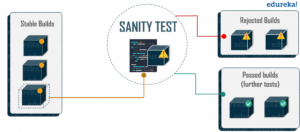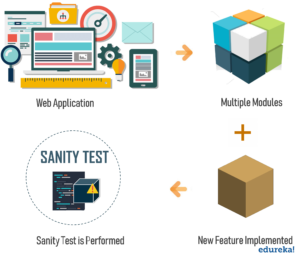Selenium Course
- 64k Enrolled Learners
- Weekend/Weekday
- Live Class
In this accelerating and increasingly digital business world software development and software testing play a very crucial role. Software testing is vital to release efficient, effective and reliable software at a rapid pace. There are different types of software testing and each of these types has a different purpose and provides a unique value to the software development process. One of the most useful types of testing is sanity testing. In this article, we will explore ‘What is Sanity Testing?’ in detail.
The prime objective of any software project is to get a high-quality output while reducing the cost and the time required for completing the project. So, every software product is subjected to testing. There are many different types of software testing. Each of these testing types has its own purpose. The type of software testing that you choose depends on your testing objective, the complexity, and functionality of your software, and your testing team. The image below lists out some of the most common types of software testing used today.
In this article, our main focus is on sanity testing. Let’s get started!
Sanity Testing is a type of software testing which is usually performed on a stable build to ascertain that bugs have been resolved and there are no new defects introduced due to changes in the code, or functionality of software product.

The main goal of sanity testing is to verify the correctness and rationality of the software. It is usually done near the end of a test cycle and focus on new functionality or defects in previously existing functionality. Listed below are the main objectives of sanity testing:
Basically, sanity testing is surface level testing, which helps in deciding if the software build is good enough to pass it on to the next levels of testing. To understand the concept more properly, this ‘What is Sanity Testing?’ article further lists the features of sanity testing.
Features of Sanity Testing
Listed below are the key features of sanity testing:
Now that we have a clear understanding of what sanity testing is and it’s key features, let’s check out how to conduct sanity testing.
Unlike other types of software testing, there is no hard and fast rule to carry out the process of sanity tests. To make sure that sanity tests are quick and speedy testers usually do not script the test cases. You need to remember that the main objective here is, to ensure that false results or bugs are not present in component processes. Also that the new features have not affected the functionalities of existing features. To carry out sanity testing you can follow three simple steps listed down below:
Identification: The first thing is to identify the new functionalities and features along with the modification or changes introduced in the code when fixing bugs
Evaluating: Next step is to check if the newly implemented features and functionalities are working as intended and according to specifications
Testing: Randomly check all the related parameters, associated functionalities and elements of the above-evaluated features and changes to ensure they are working fine
If the three steps went good, the release can be passed for thorough testing. Let’s try to figure this out with a real-time example.
Imagine a scenario where you have an application with multiple modules. In module X, you have a user registration form that allows the user to enter the data and submit it. But now there is a new requirement from a user. Which is to add ‘Preview Profile’ button in the user registration form that enables him to preview his profile before details are submitted.

The development team implements the requirement and sends the product for sanity testing. First, you perform some basic tests on the newly added feature, ie, ‘Preview Profile’. Then you check if the submit button is still working. Also, verify other functionalities and features that are dependent on the registration form. If the product passes the sanity testing, you can subject it for further testing. If not, you can reject the build. Well, this is not a fixed procedure. Every organization has its own way of performing sanity tests according to their requirements.
You might be thinking as to what is the need for sanity testing when there are other superior types of testing. In the next part of this ‘What is Sanity Testing?’ article, let’s discuss the advantages of performing smoke testing.
Listed below are the advantages of subjecting software builds to smoke testing before sending it for rigorous testing:
Now that you know how to perform sanity testing and its benefits, let’s take this ‘What is Sanity Testing?’ article, a step further and discuss how it is different from smoke testing.
Smoke testing and sanity testing are two very different practices. But people still get them confused, since the distinction is somewhat subtle. The table below lists the key differences between smoke testing and sanity testing.
| Features | Smoke Testing | Sanity Testing |
System Builds | Initial builds are subjected to smoke testing | Relatively stable builds are subjected to sanity testing |
Motive of Testing | To measure the stability of the newly created build to face off more rigorous testing | To evaluate rationality & originality of the functionalities of software builds |
Components Tested | Tests are executed on entire system end-to-end | Only certain components of the system are tested |
Documentation | Involves documentation and scripting work | Doesn’t emphasize any sort of documentation or scripting |
Test Coverage | Shallow & wide approach to include all the major functionalities without going too deep | Narrow & deep approach involving detailed testing of functionalities and features |
Performed By? | Executed by developers or testers | Executed by testers |
In simple terms, smoke testing ensures that the fundamentals of the software are sound, while sanity testing looks back to see if the changes made after additional development and testing broke anything.
So, that’s it, guys! With this, we have reached the end of this article. Hopefully, by now, you have the basic knowledge of what sanity testing is. In conclusion, sanity testing offers quick, broad and shallow testing to decide if it is possible and reasonable to proceed with further rounds of testing Developers and others alike can use sanity tests in software projects, and can dramatically improve code quality.
If you found this “What is Sanity Testing?” article relevant, check out the live-online Selenium Certification Training by Edureka, a trusted online learning company with a network of more than 250,000 satisfied learners spread across the globe.
Got a question for us? Please mention it in the comments section of this ‘What is Sanity Testing?” article and we will get back to you.
 Thank you for registering Join Edureka Meetup community for 100+ Free Webinars each month JOIN MEETUP GROUP
Thank you for registering Join Edureka Meetup community for 100+ Free Webinars each month JOIN MEETUP GROUPedureka.co